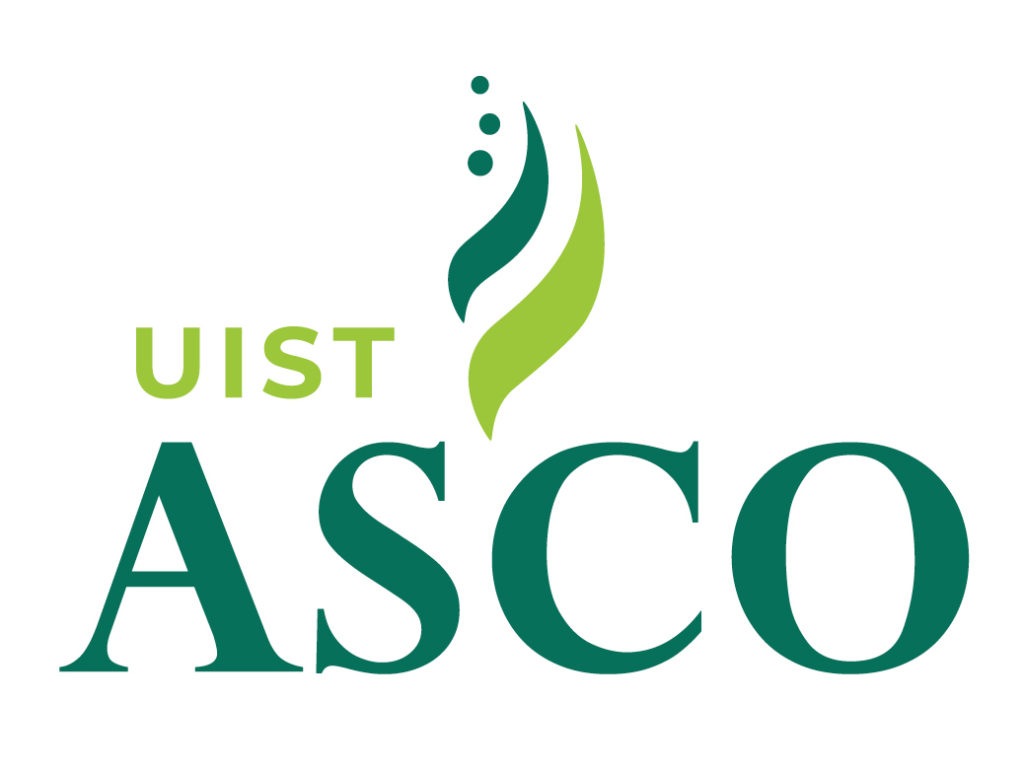By: Charles Alexander Cameron
The collection of seaweed and the manufacture of “kelp” was at its height around 1815 and was a significant source of income to the local landowners and to the crofters who collected the seaweed and paid their rent with it. Minerals extracted from the seaweed were used for various processes, including the manufacture of soap and glass. This particular industry became unviable in Scotland after a price collapse caused by competition from alternative sources abroad (particularly Spain), linked with the end of the Napoleonic Wars, and a change in government taxes. It was a disaster for the economy of the Scottish Islands, including Uist. Iodine extraction from kelp began as an alternative, though smaller, source of revenue. It was a more skilled and difficult process. This was also later subject to foreign competition (this time from South America) and by 1900 it likewise began to peter out.
During the latter part of the 19th century it was discovered by Edward Curtis Stanford that Alginate could be extracted from seaweed. In about 1935 a factory for this purpose was established in South Argyll. The product from this factory was used in the Second World War for the manufacture of camouflage nets and other products for the forces. This factory closed when another one was built in South Uist, where there was an abundance of seaweed. The species used was Laminaria, generally known as Tangle. These rods were washed up on the shore during winter gales, and crofters would collect them and place them on stone walls or wooden poles to dry. In the spring when the rods had dried, Cefoil, the original name of the company, would buy these and take them to the factory to be fully dried, milled and bagged. They were then sent to the company’s chemical factory near Oban or Girvan in Ayrshire.
I joined the company, which changed its name to Alginate Industries Ltd., in 1948 as factory manager (initially on South Uist alone) and was responsible for the collection of the rods. The resulting product was mainly used as a suspension agent for ice cream and had a good market in Australia. About a year after I joined, it was discovered that many Alginates could be made from Ascophyllum nodosum, or rockweed, so a new drier was built for this, and more collectors were recruited. This was more of a full-time occupation although the cutting of the seaweed could only be done at spring tides. Boats and nets had to be used for the collection of the seaweed, which was then transported over to the factory and dried there.
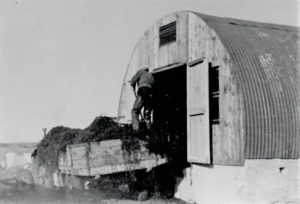
In 1955, another factory was built in North Uist at Sponish, and seaweed collection started on that island. Later a second drier was added. The company also had a seaweed factory in the Republic of Ireland in Connemara, the ownership of which was divided between Alginate Industries and the Irish Government.
As production increased, and the number of Alginate products became more diversified, further sources of seaweed had to be found. Another factory was built in the Isle of Lewis and one in County Donegal and two small boats were purchased to take weed collected on the Isle of Skye or the West Coast of Scotland to the Lewis factory. Seaweed was also imported from Norway and eventually from Tasmania where it was processed into meal and finally from Chile and Iceland. By this time many different products were being processed at the chemical factories and up to 60% or more was being exported, for which we were given the government’s export award.
By 1977, Alginate Industries had become a public company quoted on the stock exchange. In 1979, a company called Kelco, from California, put in an offer to buy it, which was accepted by the shareholders. This offer was examined by the Highlands and Islands Development Board (now Highland Enterprise) who were assured by the Americans that there would be no redundancies and so the purchase was agreed. Kelco was the biggest Alginate producer in the world, and our company was the second largest. However, not long after this all the factories in the Hebrides were closed, followed by the chemical factories on the mainland. The Irish factory, Arramara Teo., was taken over by their Government and is still in existence producing meal for agricultural products. Acadian Seaplants, from Canada, acquired it in 2014.
I retired from the company in 1980 shortly after the takeover, having been with them for 32 years. When I joined it was in a bad way financially and running the factory was very much “make do and mend” and the amount paid to the collectors was quite small. When I left, it was a public company with a turnover of over £1 million.
One of the high points in my time in South Uist was the visit of the Queen and the Duke of Edinburgh to the factory in 1956. They had not seen anything of the Uists before, so were very interested in what we were doing.
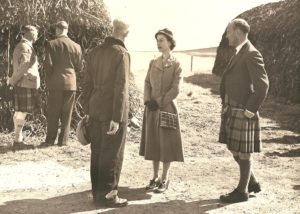
Royal visit: Charles Cameron is the kilted figure beside the Queen.
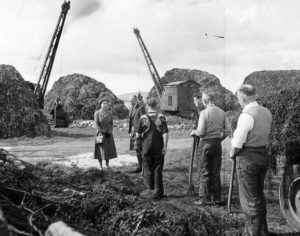
I was rather proud of starting up the factory in North Uist in 1955. I found the site and saw its potential. I arranged for the company to buy Sponish House for a very low cost from the North Uist estate. The top floor was used for the residence of the manager, and the ground floor and basement as facilities for an office and storage. The walled garden became the factory building site, with the demolished walls being used as foundations. We built a pier in the small bay which was used by the “puffers”, the small coastal boats popular at that time in the Highlands and Islands. The puffers imported the coal for the furnaces and exported the meal to the factory at Girvan. This pier cost us £1,400, as we built it ourselves, while the Department of Agriculture estimated it would cost £8,000.
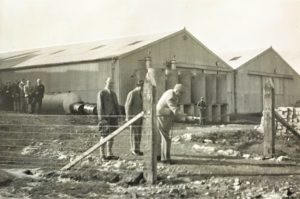
Opening of Sponish factory by Lord MacDonald, Lord Lieutenant of the County.
After the factory at Sponish was closed, a cement company took over the premises, but they later went bankrupt. The house was then bought by a private individual and the rest of the site, including the factory, was demolished.
I often reflect on my days in the seaweed business and today, with the emergence of Uist Asco, I am once again optimistic that the business of seaweed collection and processing is once again alive and well in Scotland. May it ever be thus.
Written by Charles Alexander Cameron, January 2020. Charles was Director and General Manager of Alginate Industries (Scotland), responsible for all seaweed collection and processing. In addition, he was a Director and Manager of Arrarmara Teo., the Irish company. He is now in his hundredth year and lives independently in Perthshire close to his daughter and her family.
